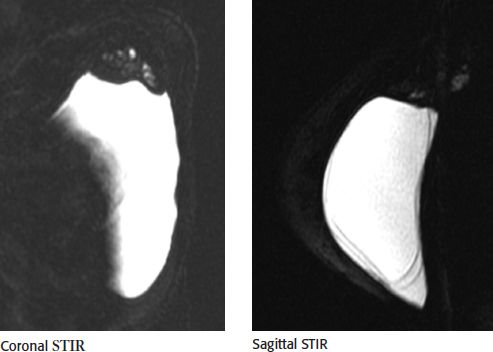Breast Imaging: A Core Review (21 page)
Read Breast Imaging: A Core Review Online
Authors: Biren A. Shah,Sabala Mandava
Tags: #Medical, #Radiology; Radiotherapy & Nuclear Medicine, #Radiology & Nuclear Medicine
E. Stereotactic biopsy
48
A 77-year-old female with the following imaging finding.

What is the most likely diagnosis?
A. Fibroadenoma
B. Tubular carcinoma
C. Complex cyst
D. Mucinous carcinoma
E. Lobular carcinoma
49
What is the diagnosis based on the following images?

A. Intracapsular implant rupture
B. Intact implant with radial folds
C. Extracapsular implant rupture
D. Silicone gel bleed
E. Intra- and extracapsular rupture
50a
A 55-year-old high-risk patient presents for screening breast MRI. No comparison available. The following contrast-enhanced breast MR images are available:

The appropriate BI-RADS category is
A. 0
B. 1
C. 2
D. 3
E. 4
50b
What is the next most appropriate step?
A. 6-month follow-up breast MRI
B. Focused ultrasound/mammography
C. Annual screening breast MRI
D. MRI-guided breast biopsy
E. Repeat breast MRI
51a

Based on the images, what is the appropriate BI-RADS assessment?
A. BI-RADS 2
B. BI-RADS 3
C. BI-RADS 4
D. BI-RADS 6
51b
Based on the images, what is the most common diagnosis?
A. Intraductal papillary carcinoma
B. Intraductal papilloma
C. Ductal carcinoma in situ
D. Invasive ductal carcinoma
52
A 56-year-old female arrives to the mammography department and tells the technologist that she feels a lump in the right upper outer breast. Upon diagnostic workup, several bilateral masses were visualized. The masses were oval in shape, similar in size, and >80% of the margins were visualized. Upon review of prior studies, similar findings were seen 3 years prior. What is the appropriate BI-RADS category?
A. BI-RADS 0
B. BI-RADS 2
C. BI-RADS 3
D. BI-RADS 4
E. BI-RADS 6
53
A 45-year-old female had a biopsy of a hypoechoic mass-like area in the right breast, and the pathology result was radial scar. Which of the following statements about radial scar is correct?
A. There is skin retraction and thickening associated
B. Incidence is 0.1 to 2 per 1,000 screening mammograms
C. Related to prior surgery or trauma
D. No association with cancer
54
A 56-year-old female presents with a palpable finding in the right breast. Patient states she takes Coumadin. Mammogram images A and B and ultrasound image C are given.

What is the BI-RADS assessment?
A. BI-RADS 1
B. BI-RADS 2
C. BI-RADS 3
D. BI-RADS 4
E. BI-RADS 0
55
A 52-year-old woman had a stereotactic core biopsy of the following calcifications results were atypical ductal hyperplasia. What is the next appropriate step in the management?

A. No further intervention is required.
B. Follow-up in 6 months
C. Follow-up in 12 months
D. Surgical excision
56
Regarding fibrocystic changes, which of the following is a correct statement?
A. More common in patients younger than 30 years of age
B. Enhances homogenously on T1-weighted sequence of breast MRI
C. Thick peripheral enhancement suggests simple cyst
D. Cysts originate from terminal lobules
E. Size of the cysts gets bigger with time
57
What is the most common pleural presentation of breast cancer?
A. Pleural effusion
B. Pleural-based soft tissue nodules
C. Round atelectasis
D. Pleural and pulmonary metastatic nodules
E. Interstitial reticulonodular changes extending to the pleura
58
A stereotactic breast biopsy shows radial scar. What is the most appropriate treatment?
A. 6-month follow-up
B. Resume yearly routine screening mammogram
C. Surgical excision
D. Second-look ultrasound
E. Rebiopsy
59
In breast MRI, which one of the following is a feature of malignant finding?
A. Lobulated border of a lesion
B. Dark internal septations without significant enhancement
C. Thick rim enhancement
D. A lesion parallels Cooper ligament
E. Microcysts
60
Regarding phyllodes tumor, which one of the following is a correct statement?
A. The pathology is usually very different from fibroadenoma.
B. It is considered a benign neoplasm, although the size at presentation is usually large and is rapidly growing.
C. Complete surgical excision often curative, but chemotherapy and radiation therapy are usually needed at the same time.
D. It is a biphasic neoplasm with double-layered epithelial component surrounded by overgrowing stroma.
Other books
The Piper's Son by Melina Marchetta
Left for Undead by L. A. Banks
Human Extinction Level Loss (Book 3): Liberation by McClimon, Philip A.
Ivyland by Miles Klee
A Persian Requiem by Simin Daneshvar
A Kiss Before Dawn by Kimberly Logan
Tyrant: Destroyer of Cities by Christian Cameron
Fuck The Police by Lauren Summer
Murder on the Potomac by Margaret Truman
Half-Breeds: Krinza's Dragon by Kriss Wilt